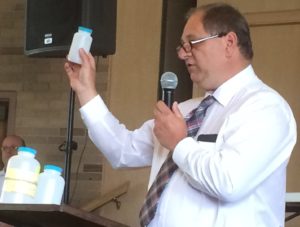By Jan Worth-Nelson
This article was updated at 1 p.m. Monday Oct. 3.
A year after Flint residents first started testing their water, making Flint into what experts now describe as “the most monitored city in America,” residents are being asked not just to continue but to change their home testing process from one bottle to two.

George Krisztian, Flint action plan coordinator for the MDEQ, shows the new smaller bottle to be added to residents’ home testing. The larger bottle, slightly smaller than the old version, is at left.
George Krisztian, Flint action plan coordinator and laboratory director for the Michigan Department of Environmental Quality, explained to a recent Flint Recovery Group meeting at City Hall that the change is intended to keep an eye on lead leaching not just from service lines, but also from sources inside the home, in particular the faucets. The goal is to determine what if any effect the fixtures are having.
Flint residents have provided about 25,000 test kits to the DEQ so far, Krisztian said, out of a total of 38,000 lead and copper samples processed since Oct. 1, 2015. He said the overall total included 8,000 school samples; 4,000 “Sentinel” samples, from a group of homes selected for extra scrutiny; and the rest from food establishments and “other investigations.”
He explained the change in the testing protocol was propelled by a series of tests at Flint elementary schools. Testers found that even though the schools did not have lead service lines, lead still was showing up in the results. It turned out the fixtures, some of which were brass with lead elements, were the culprit.
He said up until January, 2014, brass water fixtures were allowed to have up to eight percent lead, “a significant amount.” New regulations dictate a maximum of 0.25 percent, a much more stringent standard.
The new kits, provided in a Ziploc bag containing both bottles and a set of instructions will be available soon at all the water distribution centers, one center in each ward. An attached sheet will explain why the kit is different. Residents can take their old test kits to any of the nine water distribution sites, where they will be swapped one for one, Krisztian explained.
The home testing process will be a bit different, too, he explained.
Residents are asked to start with the smaller (250 ml) bottle, take caps off, set caps upside down, put it under the faucet, and as water’s running, grab the 750 ml bottle, holding it next to the other, and as soon as the first one fills up, move it under the water stream. He stressed not to turn off the faucet because that might have an effect on the flow of lead.
He explained by doing a first test directly from the “first draw” of the day, residents would be essentially concentrating on that “slug of lead” that might be coming from the faucet. Then with the second sample, he said, “if there is an issue with the faucet, we would expect that the numbers would drop down.”
He said residents should test on either the kitchen or bathroom fixtures, as always.
While test samples can no longer be delivered directly to the water plant, they can be dropped off at any of the city’s nine water distribution sites, one in each ward. Locations of the sites are listed at flintcares.org.
If results show that the faucet is a problem, Krisztian said, “I’m still working on” what will happen next. He said “When you’re dealing with a scientific project like this, before you make the ask you have to have the evidence. We have a lot of evidence from the schools, but the question is how does that translate into the homes.”
Results will be available in about the same amount of time as the former sampling process, he said — about a week or so for snail mail, sooner for those with Internet access. The water testing service is provided to all residents free of charge, he noted, as it has been since testing began.
Krisztian said the new kits are not at the water distribution centers yet but are expected in a week or two.
Flint residents have been testing their water since October, 2015 when the lead crisis kicked into high gear after findings from Virginia Tech’s Marc Edwards and Hurley Hospital pediatrician Dr. Mona Hanna-Attisha exploded into national headlines.
EVN Editor Jan Worth-Nelson can be reached at janworth1118@gmail.com.


You must be logged in to post a comment.